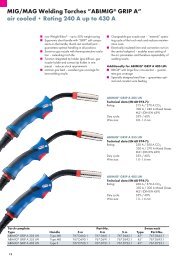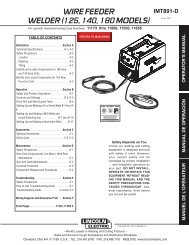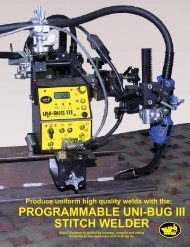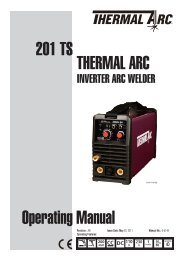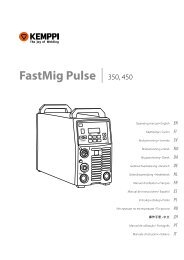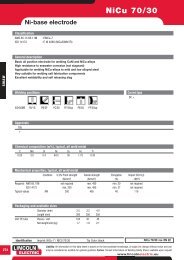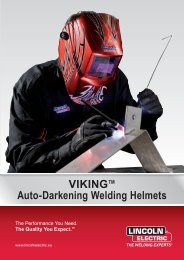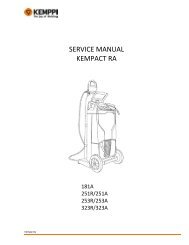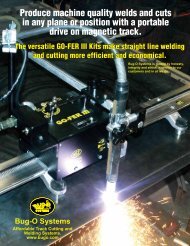oxy/acetylene welding and cuttng - Rapid Welding and Industrial ...
oxy/acetylene welding and cuttng - Rapid Welding and Industrial ...
oxy/acetylene welding and cuttng - Rapid Welding and Industrial ...
Create successful ePaper yourself
Turn your PDF publications into a flip-book with our unique Google optimized e-Paper software.
IntroductionOxygen/Acetylene <strong>welding</strong>, or “Gas <strong>Welding</strong>”, is a process which relies on combustion of <strong>oxy</strong>gen <strong>and</strong><strong>acetylene</strong>. When mixed together in correct proportions within a h<strong>and</strong>-held torch or blowpipe, a hot flame isproduced with a temperature of about 3,200°C. The chemical action of the <strong>oxy</strong>/<strong>acetylene</strong> flame can be adjustedby changing the ratio of the volume of <strong>oxy</strong>gen to <strong>acetylene</strong>, using the valves on the torch or blowpipe.EquipmentOxy/<strong>acetylene</strong> equipment isportable <strong>and</strong> easy to use. Itcomprises <strong>oxy</strong>gen <strong>and</strong> <strong>acetylene</strong>gases stored under pressure insteel cylinders. The cylindersshould be fitted with regulators, tocontrol the pressure <strong>and</strong> flow ofgases. Flexible hoses are used toconnect the regulators to the torchor blowpipe. Specially designedsafety devices, called flame trapsor “Flashback Arrestors” are fittedbetween the hoses <strong>and</strong> theregulators. Flashback arrestorsprevent flames generated by a'flashback' from reaching thecylindersFlashbacksA flashback is a rapid, highpressureflame travelling back upthe gas hoses, caused by <strong>welding</strong>or cutting at incorrect pressuresettings, or from blockage oroverheating of the nozzle (forexample by operating with thenozzle too close to the material)Flashbacks can result in extremelydangerous cylinder ignition <strong>and</strong>must be prevented by proper useof working Flashback Arrestors.Lighting-Up ProcedureFig. 1 Oxy/Acetylene EquipmentTo begin <strong>oxy</strong>gen/<strong>acetylene</strong> <strong>welding</strong> or cutting, open thecylinder valves slowly by means of the cylinder key(s).Do not open suddenly or there may be serious damage to the regulator <strong>and</strong> the possibility of an accident.Open the cylinder valve spindles one turn only. Open the fuel gas control valve on the blowpipe <strong>and</strong> adjust theregulator to give the correct working pressure (see chart on page 13), this ensures that any air or <strong>oxy</strong>gen ispurged from the hose. Repeat the procedure for the <strong>oxy</strong>gen side.http://www.rapid<strong>welding</strong>.comLight the gas by means of a suitable sparklighter making sure that the sparklighter is held at right angles to thenozzle. Do not use liquid igniters (such as cigarette lighters) as the vapour/gas combination can be dangerous.Reduce or increase the <strong>acetylene</strong> supply to the blowpipe valve until the flame just ceases to smoke.Slowly increase the <strong>oxy</strong>gen via the blowpipe control valve until the white inner cone in the flame is sharplydefined with the merest trace of an <strong>acetylene</strong> haze. The blowpipe is now correctly adjusted.www.weldability.com | support@weldability.com page 2 of 13
WELDING TECHNIQUESLeftward <strong>Welding</strong>Leftward <strong>Welding</strong> is used on steel for flanged edge welds, for unbevelled plates up to 5.0mm (3/16in). It is alsothe method usually adopted for cast iron <strong>and</strong> non-ferrous metals. <strong>Welding</strong> is started at the right-h<strong>and</strong> end of thejoint <strong>and</strong> proceeds towards the left.Fig. 2 Leftward <strong>welding</strong>The blowpipe is given a forward motion with a slight sideways movement to maintain melting of the edges ofboth plates at the desired rate <strong>and</strong> the <strong>welding</strong> rod is moved progressively along the weld seam – see fig. 2.The sideways motion of the blowpipe should be restricted to a minimum.Rightward <strong>and</strong> all position rightward <strong>welding</strong>Rightward <strong>welding</strong> is recommended for steel plate over 5.0mm (3/16in) thick. Plates from 5.0mm to 8.0mm(3/16in to 5/16in) need not be bevelled; over 8.0mm (5/16in) the edges are bevelled to 30o to give an includedangle of 60o for the <strong>welding</strong> V. Suitable for horizontal/vertical position.http://www.rapid<strong>welding</strong>.comFig. 3 Rightward <strong>Welding</strong>The weld is started at the left-h<strong>and</strong> end <strong>and</strong> moves towards the right with the blowpipe flame preceding the fillerrod in the direction of travel. The rod is given a circular forward motion <strong>and</strong> the blowpipe is moved steadilyalong the weld seam – See Fig. 3 This is faster than leftward <strong>welding</strong> <strong>and</strong> consumes less gas; the V angle issmaller, less filler rod is used <strong>and</strong> there is less distortion. The all-position rightward technique is a modificationof the above <strong>and</strong> is particularly suitable for mild steel plate <strong>and</strong> pipe in the vertical <strong>and</strong> overhead position – SeeFig. 4 on page 4.www.weldability.com | support@weldability.com page 3 of 13
http://www.rapid<strong>welding</strong>.comFig. 4 All-position rightward <strong>welding</strong>. Butt-welds in mild 5 - 8mm (3/16 - 5/16in) thick.www.weldability.com | support@weldability.com page 4 of 13
The advantages are that it enables the welder to obtain a uniform penetration bead <strong>and</strong> an even build-up,particularly in fixed position <strong>welding</strong>; the welder can work with complete freedom of movement <strong>and</strong> has a clearview of the weld pool <strong>and</strong> the fusion zone of the joint. Considerable practice is required to become familiar withthis technique even by operators skilled in normal downh<strong>and</strong> rightward <strong>welding</strong>. An apparent undercutting ofthe plate surface at the edges of the weld bead is a fault to which this technique is prone but this can becontrolled by appropriate manipulation of the rod <strong>and</strong> flame. The rod <strong>and</strong> blowpipe angle should be adjusted togive adequate control of the molten metal as in normal rightward <strong>welding</strong>.Fig. 5 Vertical <strong>welding</strong>, single-operator for plate thicknesses up to 5.0mm (3/16in)http://www.rapid<strong>welding</strong>.comwww.weldability.com | support@weldability.com page 5 of 13
Vertical <strong>Welding</strong>Vertical <strong>welding</strong> may be used on unbevelled steel plate up to 3mm (1/8in) thickness <strong>and</strong> up to 15mm (5/8in)when two welders are employed working on both sides of the joint; <strong>welding</strong> starts at the bottom <strong>and</strong> proceedsvertically. See Fig. 5 <strong>and</strong> 6 for methods of blowpipe <strong>and</strong> <strong>welding</strong> rod manipulation for single-operatortechniques.When the two-operator method is used, the two welders must be trained to work in harmony.Fig.6 Vertical <strong>welding</strong>, two operators for plates thicker than 5.0mm (3/16in)http://www.rapid<strong>welding</strong>.comwww.weldability.com | support@weldability.com page 6 of 13
Fig. 7 Edge preparationshttp://www.rapid<strong>welding</strong>.comwww.weldability.com | support@weldability.com page 7 of 13
Bronze <strong>Welding</strong>Bronze <strong>Welding</strong> involves the use of alloy bronze rods <strong>and</strong> is used for making joints in copper, for joiningdissimilar metals, <strong>and</strong> for repairs to cast iron.Among the rods used are fluxobronze, a flux-coated silicon bronze, plain silicon bronze, plain nickel bronze <strong>and</strong>manganese bronze with suitable flux.It is essential that the edges of the materials should not be melted but merely raised to red heat. For examplewhen bronze<strong>welding</strong> cast iron, a manganese bronze rod should be used; this melts at 895º C, well below themelting point of cast iron. The fracture, or the edges of the metal to be joined are prepared in the usualmanner, care being taken to ensure that all sharp edges are rounded-off <strong>and</strong> that they are absolutely clean.The joint so formed has excellent mechanical properties <strong>and</strong> providing there is no objection to dissimilarity incolour, bronze<strong>welding</strong> can be recommended for a variety of purposes.Fractured castings should be pre-heated before <strong>welding</strong>.Depositing Hardfacing RodsThis is a process which consists of laying down a hard deposit which is very resistant to wear on a steel or castiron surface <strong>and</strong> finds wide application in building-up wearing services on well-boring drills, dies, picks, valveseats, punches, knives, crushing <strong>and</strong> excavating machinery, etc.For steel, the flame is adjusted to an excess of <strong>acetylene</strong> to give a feather of 1 ½ to 2 ½ times the length of thenormal neutral inner cone. The steel is raised to a dull red-heat <strong>and</strong> when the surface begins to ‘sweat’ the rodis deposited on the surface – see Fig. 8. Upon completion the work must be cooled slowly either in a furnace orin lime or mica dust.The deposition of hardfacing on cast iron is not as successful as on steel. Since cast iron cannot be made to‘sweat’ it is advisable first to fuse a layer of hardfacing rod on to the surface as in the case of <strong>welding</strong> using aCast Iron flux, then to ‘sweat’ a second layer onto the previous deposit.Rods containing tungsten carbide are also deposited with this technique.http://www.rapid<strong>welding</strong>.comFig. 8 Hardfacing ProcedureBuilding-up worn surfaces (Hardfacing)For building-up surfaces subject to a large amount of wear it is usual to deposit a rod, which has special wearresistingproperties. An excess <strong>acetylene</strong> flame is used to deposit the metal; the base metal is pre-heated, asstated above <strong>and</strong> when it begins to ‘sweat’ the rod is melted on to the surface. The weld metal should beadded in small deposits <strong>and</strong> the whole surface gradually built up to the required thickness. There is a widerange of high-carbon <strong>and</strong> alloy steel rods which, with appropriate flame adjustment, may be used for building upgear teeth, splines, keyways <strong>and</strong> worn parts in general.www.weldability.com | support@weldability.com page 8 of 13
Nozzle MaintenanceDo not maltreat a nozzle. Do not use it as a hammer or lever.To clean nozzle orifices, sets of special nozzle cleaning reamers are available from your local distributor, seeFig.9. Should these not be available use a drill one size smaller than the orifice <strong>and</strong> work it up <strong>and</strong> downwithout twisting; the drill should be held in a pin vice. If the drill does not enter easily start with a smaller drillincreasing the size until the correct diameter is attained. Effective flame shape can only be maintained if gasorifices are sharp <strong>and</strong> square with the end of the nozzle. If a nozzle becomes damaged on the end, rub it downwith a sheet of fine emery laid on a flat surface such as a sheet of glass taking care to keep to keep the nozzlesquare with the rubbing service. The orifice should then be cleaned out as described above. The nozzle hasbeen designed to make this reconditioning possible.DO NOT use other than recommended wire reamers or broaches to clean out the orifices.Fig.9 Nozzle Cleaninghttp://www.rapid<strong>welding</strong>.comwww.weldability.com | support@weldability.com page 9 of 13
Type 3 Shank & CutterL/W Shank & CutterNM Style Cutting TorchFig. 10 Styles Of Cutting Torch Equipment (“blowpipes”)N.B. It is essential when using a combined outfit (Type 3 or L/W) to open the <strong>oxy</strong>gen valve or the shank fully. Ifthis is not done there will be starvation of <strong>oxy</strong>gen at the nozzle when the cutting <strong>oxy</strong>gen lever is depressed.CUTTING TECHNIQUESGeneralAssemble the equipment <strong>and</strong> arrange the material to be cut in a convenient position; faster cutting <strong>and</strong> asmoother finish are possible if rust <strong>and</strong> scale are removed from the path of the cut. Light up the nozzle <strong>and</strong>hold the blowpipe with the nozzle at right angles to the plate <strong>and</strong> apply the heating flame to the edge of thematerial furthest from the operator. A spade or nozzle attached to the nozzle is of assistance in holding theblowpipe steady.When the edge of the metal attains a bright red heat, operate the cutting <strong>oxy</strong>gen lever <strong>and</strong> draw the blowpipetowards the body along the line of cut at a speed recommended in the data tables.The above remarks apply to the severance of mild steel plate of normal thickness. The following points shouldbe noted for differing cutting requirements.http://www.rapid<strong>welding</strong>.comFig. 11 Cutting torch position basicswww.weldability.com | support@weldability.com page 10 of 13
Thick MaterialBecause of heavy gas consumption when cutting thick material, ensure that there is an adequate supply of fuelgas <strong>and</strong> use a battery of <strong>oxy</strong>gen cylinders coupled together or pipeline supplies. On very thick material, a cutmay be started on the bottom face; gradually work up the edge with the blowpipe until the top is reached thencontinue the cut in the usual manner.Painted <strong>and</strong> Galvanised MaterialClean the surface before starting to cut. It is often an advantage to incline the tip of the nozzle toward the bodyto help to undercut paint or scale. Unless ventilation is very good fume extraction should be installed at thepoint of cutting. In some cases it may be necessary to use a respirator as well.Round BarNick the bar with a chisel at the point where cutting is to start, alternatively apply the end of a piece of steel wireheated to a bright red.Hole CuttingFor cutting holes in mild steel plate or pipe, mark out the area to be removed; cutting should be commencedwithin the area that will become scrap.Within the scrap area, heat a spot to a bright red heat then very slowly operate the cutting <strong>oxy</strong>gen control until ahole is pierced through the material. Now move the blowpipe at cutting speed to the edge of the area to beremoved <strong>and</strong> follow round the marked out contour until the scrap portion is severed from the parent metal.When using a pierce start it is important that the cutting <strong>oxy</strong>gen valve is opened slowly to avoid a splash of hotmetal <strong>and</strong> that the nozzle be presented at a slight angle so as to avoid slag being thrown back onto the nozzle.Cast IronApply the technique shown in Fig.12. The heating flame should be trimmed to give a large access of <strong>acetylene</strong>so that the cone has a length of 50 to 75mm (2 to 3in) before cutting <strong>oxy</strong>gen is turned on. Only high pressuredissolved <strong>acetylene</strong> can be used for cutting cast iron.It is not possible to cut a clean edge <strong>and</strong> because of the large amount of heat produced it is advisable to weargauntlets <strong>and</strong> protective clothing.http://www.rapid<strong>welding</strong>.comFig.12 Cutting Cast Ironwww.weldability.com | support@weldability.com page 11 of 13
Cutting Nozzle MaintenanceDo not maltreat a nozzle. Do not use it as a hammer or a lever.To clean nozzle orifices, sets of special nozzle cleaning reamersare available from your <strong>welding</strong> distributor, see Fig.13. Shouldthese not be available use a drill one size smaller than the orifice<strong>and</strong> work it up <strong>and</strong> down without twisting; the drill should be held ina pin vice. If the drill does not enter easily, start with a smaller drill,increasing the size until the correct diameter is attained. It is mostimportant that the small holes at the seating end of the nozzle arenot enlarged in any way, because this may alter the gas flow, <strong>and</strong>make cutting very difficult.Effective pre-heat shape <strong>and</strong> cutting <strong>oxy</strong>gen stream can only bemaintained if gas orifices are sharp <strong>and</strong> square with the end of thenozzle. If a nozzle becomes damaged on the end, rub it down witha sheet of fine emery laid on a flat surface such as glass, takingcare to keep the nozzle square with the cutting surface. Theorifices should then be cleaned out as described above. Thenozzle has been designed to make this reconditioning possible <strong>and</strong>as much as 3mm (1/18in) may be removed before a nozzlebecomes unserviceable.Fig.13 Nozzle cleaningN.B. High speed venture type nozzles <strong>and</strong> two piece propane nozzles should not be treated in this way. Seekadvice from your distributor.http://www.rapid<strong>welding</strong>.comwww.weldability.com | support@weldability.com page 12 of 13
Typical Variables For <strong>Welding</strong> & CuttingSettings For Oxy/Acetylene <strong>Welding</strong> With Type 3 <strong>Welding</strong> EquipmentMild Steel Thicknessmm in swgOperating Pressure Gas ConsumptionNozzle Acetylene Oxygen Acetylene Oxygensize bar psi bar psi l/h ft 3 /h l/h ft 3 /h0.9 20 1 0.14 2 0.14 2 28 1 28 11.2 18 2 0.14 2 0.14 2 57 1 57 22.0 14 3 0.14 2 0.14 2 86 3 86 32.6 12 5 0.14 2 0.14 2 140 5 140 53.21 /8 10 7 0.14 2 0.14 2 200 7 200 74.03 /32 8 10 0.21 3 0.21 3 280 10 280 105.03 /16 6 13 0.28 4 0.28 4 370 13 370 136.51 /4 3 18 0.28 4 0.28 4 520 18 520 188.25 /16 0 25 0.42 6 0.42 6 710 25 710 25103 /8 4/0 35 0.63 9 0.63 9 1000 35 1000 35131 /2 7/0 45 0.35 5 0.35 5 1300 45 1300 4525 1+ 90 0.63 9 0.63 9 2500 90 2500 90Settings For Oxy/Acetylene Cutting With Type 3 or NM Cutting TorchesOperating pressureGas consumptionMild SteelCuttingCutting HeatingThickness Oxygen AcetyleneAcetylene SpeedsNozzleOxygen Oxygenmm In size bar psi bar psi l/h ft3/h l/h ft3/h l/h ft3/h mm.m in.mSheet Asnm 1.5 20 0.14 2 800 28 85 3 85 3 - -6¼ 1 /32 1.8 25 0.14 2 800 28 480 15 400 14 510 2013½ 3 /64 2.1 30 0.21 3 1900 67 570 20 510 18 480 1925 11 /16 2.8 40 0.14 2 4000 140 540 19 470 17 400 1650 21 /16 3.2/3.5 45/50 0.14 2 4500 160 620 22 560 19 300 1275 31 /16 3.5/4.2 50/60 0.14 2 4800 170 680 24 620 22 205 8100 45 /64 3.2/4.8 45/70 0.14 2 6800 240 850 30 790 27 150 6150 63 /32 3.2/5.5 45/80 0.21 3 9400 330 960 34 850 30 125 5200 81 /8 4.2 60 0.28 4 14800 510 1380 48 1250 44 100 4250 101 /8 5.3 75 0.28 4 21500 760 1560 55 1420 50 75 3300 121 /8 6.3 90 0.28 4 25000 880 1560 55 1420 50 50 2Settings For Oxy/Acetylene Gouging With Type 3 or NM Cutting TorchesOperating pressureGas consumptionMaterialCuttingThicknessCutting HeatingOxygen AcetyleneAcetylene SpeedsNozzleOxygen Oxygenmm in size bar psi bar psi l/h ft3/h l/h ft3/h l/h ft3/h mm.m in.m85 /16 13 4.0 60 0.5 7 3680 130 990 35 905 32 610 24117 /16 19 5.0 75 0.5 7 9340 330 1870 66 1700 60 1070 42121 /2 25 5.5 85 0.55 8 16270 575 2290 81 2100 74 1220 48http://www.rapid<strong>welding</strong>.comwww.weldability.com | support@weldability.com page 13 of 13



